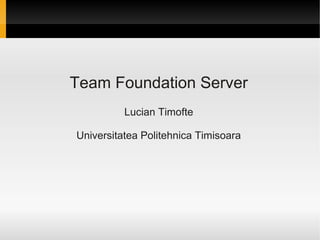Tfs
- 1. Team Foundation Server Lucian Timofte Universitatea Politehnica Timisoara
- 2. What is TFS? ŅĆŖ Team Foundation Server (commonly abbreviated to TFS) is a Microsoft product offering source control, data collection, reporting, and project tracking, and is intended for collaborative software development projects. [1] It is available either as stand-alone software, or as the server side back end platform for Visual Studio Team System (VSTS).
- 3. Architecture
- 4. Features - Version Control ŅĆŖ Team Foundation Server 2010 provides state of the art version control and seamless integration with Visual Studio. It supports teams doing parallel development and includes many powerful features like atomic check-ins, branching and merging, shelving, labeling, concurrent check-outs, check-in policies, and the association of check-ins with work items. Powerful visualization tools reduce the complexity in branching and merging and helps you understand the scope, organization, and maintenance of your source code and easily identify, track, and manage changes across branches.
- 5. Work Item Tracking ŅĆŖ Team Foundation Server 2010 features an integrated work item tracking system. Work items can consist of requirements, tasks, bugs, issues, and test cases. The work item tracking system is extensible and you can define and control fields that are presented to the user, fields that are rolled up into reports, states that the work item can be in, how state transitions should occur, and receive alerts on state changes.
- 7. Build Automation ŅĆŖ eam Foundation Server 2010 provides a robust and fully featured build automation server. You can customize Team Foundation Build and configure triggers for manual build, continuous integration, rolling builds, gated check-in, or scheduled builds. The gated check-in feature helps teams working in the same branch to prevent costly and time-consuming build breaks by testing code in isolation before it goes into the full repository. In addition, support for Windows Workflow based builds with powerful features like build queuing and build agent pooling enable you to easily customize, manage and scale out your build environments.
- 8. Reporting ŅĆŖ Powerful reports and dashboards in Team Foundation Server 2010 help you analyze and track progress and quality in real-time. Project data is stored in a data warehouse and features an OLAP cube that allows for rich reporting using Microsoft Excel and SQL Report Designer. Dashboards are based on Microsoft Office SharePoint Server (MOSS)/SharePoint Server as well as Windows SharePoint Services/SharePoint Foundation. Team Foundation Server 2010 ships with more than 30 reports out of the box and you can easily create custom reports.
- 10. Project Management ŅĆŖ Team Foundation Server 2010 allows you to work the way you want and features built-in support for Agile and waterfall methodologies. Team Foundation Server provides MSF for Agile, CMMI and SCRUM process templates; or you can choose from a number of third party process templates. Use the Microsoft Excel Agile Planning Workbook to create and manage the product backlog, estimate the teamŌĆÖs velocity, and break the project down into iterations. The Iteration Backlog enables you to plan iterations and track progress. In addition, integration with Microsoft Project enables stakeholders and project managers to gain real-time insight into project health as well as ways to improve existing processes.


![What is TFS?
ŅĆŖ Team Foundation Server (commonly
abbreviated to TFS) is a Microsoft product
offering source control, data collection,
reporting, and project tracking, and is intended
for collaborative software development projects.
[1] It is available either as stand-alone software,
or as the server side back end platform for
Visual Studio Team System (VSTS).](https://image.slidesharecdn.com/tfs-120304105616-phpapp01/85/Tfs-2-320.jpg)








